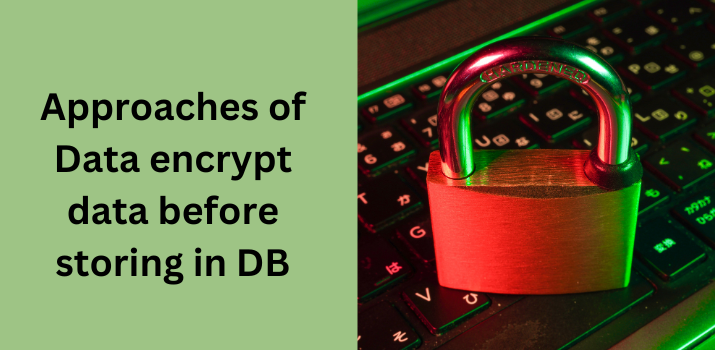What are the Different Approaches to Encrypt Data before Storing in Databse

Encrypting data before storing it in a database is an essential security measure to protect sensitive information. There are several methods and best practices to consider when encrypting data for storage:
1. Transparent Data Encryption (TDE)
TDE is a feature offered by many relational database management systems (RDBMS), such as SQL Server, Oracle, and MySQL. It encrypts the entire database at the file level, ensuring that data is encrypted when written to disk. This method is transparent to applications and users, as they can access the data without any extra steps.
2. Application-Level Encryption
Encrypt data in your application code before sending it to the database. This allows you to have full control over the encryption process. You can use encryption libraries or APIs like OpenSSL, AWS KMS, or a cryptography framework in your programming language to encrypt data before storing it.
3. Field-Level Encryption
Encrypt specific columns or fields within the database. This approach provides granular control over which data is encrypted. It is particularly useful when you need to encrypt only sensitive parts of your data. You can use application-level encryption libraries or the database's built-in encryption functions to achieve this.
4. Use Strong Encryption Algorithms
Ensure that you use strong, industry-standard encryption algorithms, such as Advanced Encryption Standard (AES) for symmetric encryption and RSA or ECC for asymmetric encryption. Always use up-to-date encryption libraries and methods to mitigate vulnerabilities.
5. Protect Encryption Keys
The security of encryption keys is paramount. Store encryption keys in a secure, separate location, such as a Hardware Security Module (HSM) or a trusted key management service. This ensures that even if an attacker gains access to the database, they won't be able to decrypt the data without the keys.
6. Key Rotation
Regularly rotate encryption keys to enhance security. This practice limits the window of opportunity for attackers who may have compromised a key. Key rotation is particularly crucial for long-term data protection.
7. Access Control
Implement strong access control mechanisms to restrict who can access and decrypt the data. Role-based access control and strong authentication methods are essential.
8. Auditing and Monitoring
Enable auditing and monitoring of data access and encryption key usage. This can help you detect and respond to suspicious activities in a timely manner.
9. Secure Database Configuration
Ensure that your database server is configured securely. Apply security patches and harden your database environment to reduce vulnerabilities.
10. Data Masking and Redaction
For non-sensitive data, consider data masking or redaction, which replaces sensitive information with fake or obscured data for certain user roles. This helps to protect privacy and meet regulatory requirements.
11. Compliance
Comply with relevant data protection regulations, such as GDPR, HIPAA, or PCI DSS, to ensure that your data encryption practices align with legal requirements.
Remember that the choice of encryption method and key management strategy may vary depending on your specific use case and regulatory requirements. It's crucial to carefully plan and implement data encryption to maintain the confidentiality and integrity of your data in the database.
Find other similar Articles here:
- JavaScript or Python which is better for the future?
- What is difference between Promise and Async await in javascript
- What is difference between monolithic architecture and microservices architecture
- Difference between for loop and forEach in Javascript
- Different ways to convert string to number in JavaScript
- Use Session Storage using Jquery